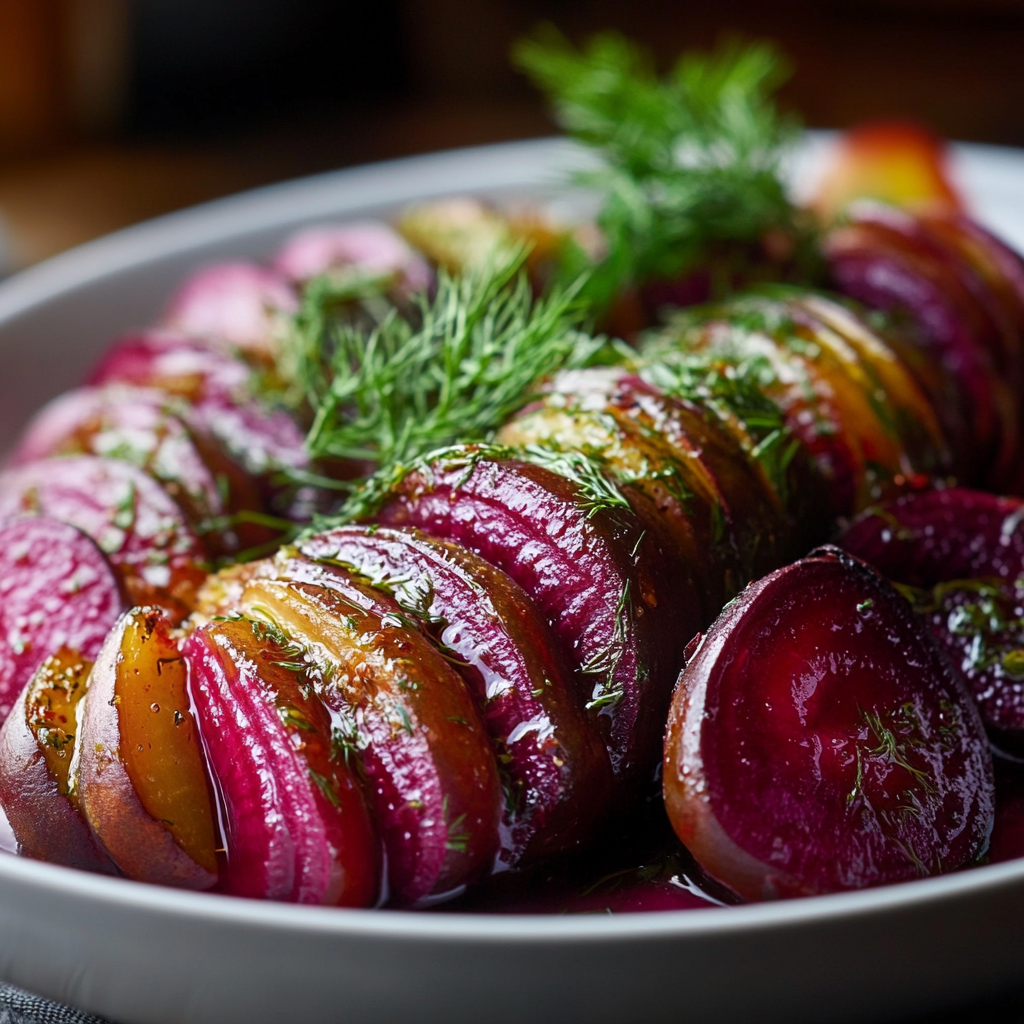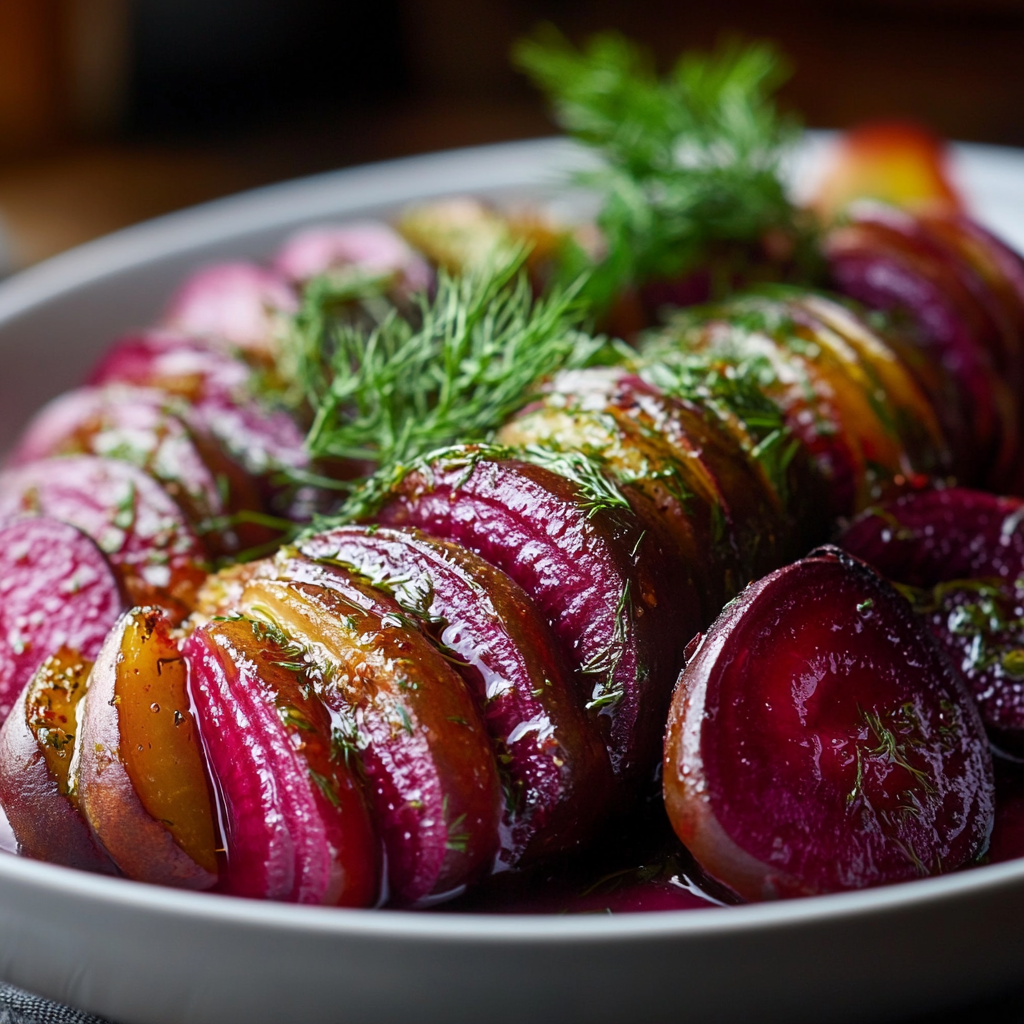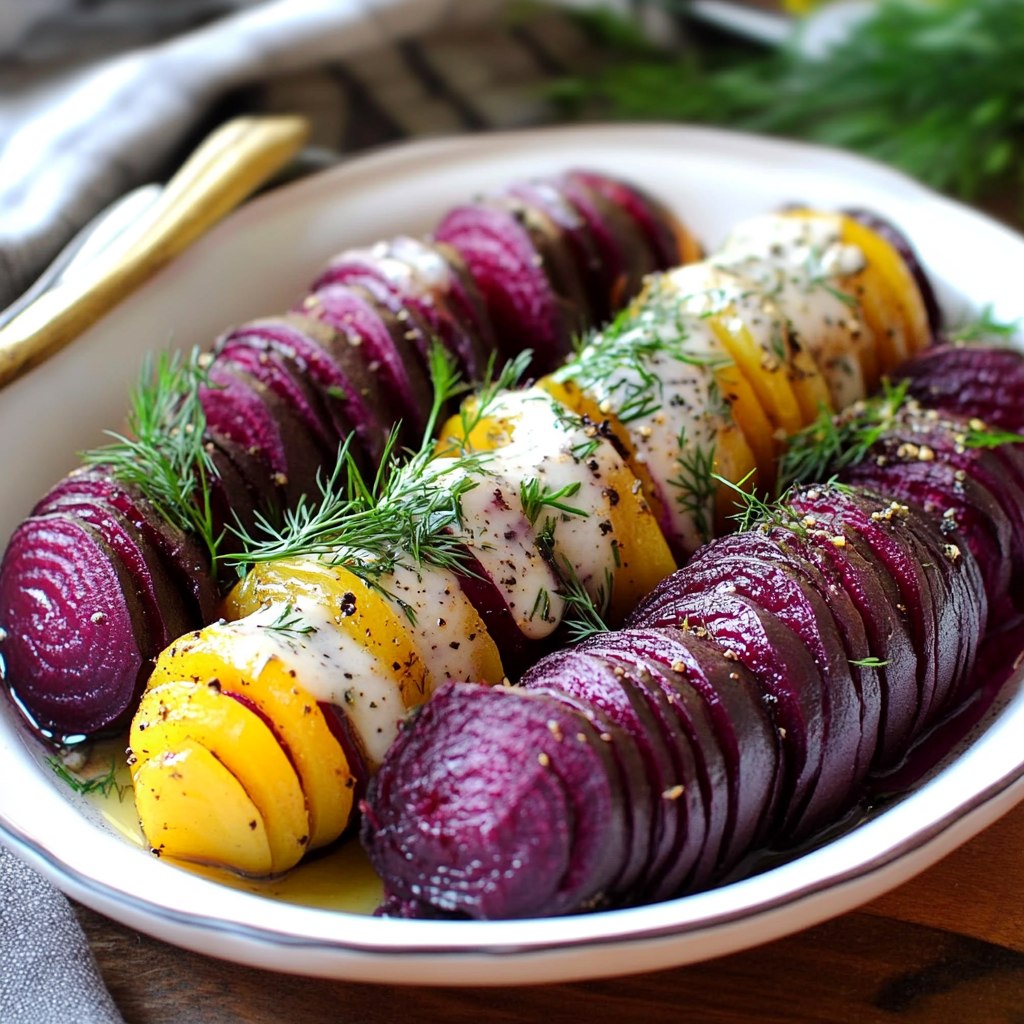The Origins and Benefits of Roasted Hasselback Beets with Fresh Dill Dressing
Roasted Hasselback Beets with Fresh Dill Dressing is a visually stunning and delicious dish that combines the earthy sweetness of beets with the fresh, tangy notes of dill dressing. This elegant side dish not only elevates the humble beet but also brings a Scandinavian touch to your table with the Hasselback preparation. By slicing the beets in thin, even cuts without going all the way through, they fan out beautifully during roasting, creating an impressive presentation and enhancing the absorption of flavors.
The fresh dill dressing, made with simple ingredients like vinegar, olive oil, and chopped dill, complements the beets perfectly. This combination is not only visually appealing but also packs a punch of flavors that are refreshing and complex. Whether you’re hosting a dinner party or looking for a new way to enjoy beets, this recipe is sure to impress with its vibrant colors and distinct taste.
This dish aligns well with various dietary preferences, including vegetarian, vegan, and gluten-free diets, making it a versatile choice for many. Beets are known for their nutritional benefits, offering a rich source of vitamins, minerals, and antioxidants. Dill, on the other hand, adds not only flavor but also a dose of vitamins and health benefits, including aiding digestion and having antibacterial properties.
The versatility of this dish allows it to be served as a side, a salad topping, or even as a standalone main course for a light meal. With its eye-catching appearance and delightful taste, Roasted Hasselback Beets with Fresh Dill Dressing is a modern take on classic ingredients that will surely become a favorite in your recipe collection.

The History and Origins of Hasselback Beets
The Hasselback technique originated in Sweden and dates back to the 1950s. Named after the Hasselbacken Restaurant in Stockholm, where this method was first popularized, it was initially applied to potatoes. The chefs at Hasselbacken creatively sliced the potatoes into thin, even layers, allowing them to fan out beautifully when roasted. This method not only added a striking visual element but also maximized the crispiness and flavor absorption of the potatoes.
Over time, the Hasselback slicing technique has been adapted to various vegetables, including sweet potatoes, zucchinis, and more recently, beets. The method involves making thin cuts along the surface of the beet, stopping just before cutting all the way through. This creates an accordion-like appearance that expands during roasting, allowing flavors to permeate deeply. You can explore more about the Hasselback technique and its applications here.
A fun fact about the popularity of the Hasselback style is that it not only enhances texture but also plays a significant role in visual appeal—a crucial factor in modern culinary presentations. This technique has become a favorite among chefs and home cooks alike, looking to elevate their vegetable dishes. By applying this method to beets, which are rich in color and nutrients, the Hasselback style has found a new, vibrant application that appeals to both the eyes and the palate.
Beets themselves have a long history of cultivation, dating back to ancient Mediterranean civilizations. Originally grown for their edible leaves, the root became popular in the 19th century. Today, beets are celebrated for their sweet flavor, vibrant color, and versatility in cooking, making them an ideal candidate for the Hasselback treatment.
The History and Origins of Fresh Dill Dressing
Dill has a rich culinary history that traces back to ancient Egypt, Greece, and Rome, where it was used not only as a herb but also for medicinal purposes. The herb made its way to northern Europe and eventually to Scandinavian cuisine, where it became a staple ingredient in many traditional dishes, including pickled vegetables and dressings. Dill is prized for its distinctive, slightly sweet and tangy flavor, which pairs well with a variety of ingredients, especially beets.
The use of dill in dressings can be particularly seen in Scandinavian and Eastern European cuisines, where fresh herbs are often used to enhance the flavor of salads, fish, and vegetables. Fresh dill dressing typically consists of a simple blend of vinegar, oil, fresh dill, and seasonings. This minimalist approach allows the vibrant flavor of the dill to shine through, making it an excellent complement to earthy vegetables like beets. Learn more about cooking with dill here.
In the context of Roasted Hasselback Beets, the fresh dill dressing not only adds a burst of flavor but also brings a historical continuity of pairing dill with root vegetables. This combination is rooted in the idea of balancing robust, earthy flavors with fresh, herbal notes—a principle that has been appreciated in traditional cuisines for centuries.
Dill dressing has also evolved over time to incorporate various ingredients like yogurt, garlic, or even honey, adapting to different culinary needs and preferences. However, the classic version remains a staple due to its simplicity and the way it elevates the taste of dishes without overpowering the main ingredients. This versatility and rich history make fresh dill dressing a beloved addition to many modern dishes, including the vibrant Roasted Hasselback Beets.
Health Benefits of Hasselback Beets with Fresh Dill Dressing
Roasted Hasselback Beets with Fresh Dill Dressing is not just a treat for the eyes and taste buds but also a powerhouse of health benefits. Beets are known for their high content of essential nutrients, including folate, manganese, potassium, and fiber. They are also packed with antioxidants, which help combat oxidative stress and inflammation in the body. This makes beets particularly beneficial for heart health, lowering blood pressure, and improving circulation due to their nitrate content.
Adding dill to the mix not only enhances the dish’s flavor but also contributes additional health benefits. Dill is rich in vitamins A and C, as well as essential minerals like iron and calcium. It has been used traditionally to support digestion, reduce bloating, and even act as a mild antibacterial agent. Together, beets and dill create a dish that is not only delicious but also highly nutritious.
The roasting process in the Hasselback method helps to preserve the nutrients in the beets while enhancing their natural sweetness. This method of cooking is also low in fat, especially when paired with a light dill dressing made from olive oil and vinegar. This keeps the dish healthy, light, and perfect for a variety of diets, including vegetarian, vegan, and gluten-free.
Moreover, this dish is an excellent option for those looking to increase their vegetable intake in a fun and appealing way. The vibrant colors and the unique presentation of the Hasselback cut make these beets a favorite among kids and adults alike. This dish can serve as a beautiful side, a salad topper, or even as a light main course.
Incorporating more beets into your diet can help improve overall health, and when paired with fresh dill, the benefits are amplified, making this dish not only a feast for the senses but also a boost for your well-being.
Combining Beets and Dill: A Perfect Flavor Match

The combination of beets and dill is a classic one, rooted in culinary traditions that value the balance of earthy and herbal flavors. Beets, with their natural sweetness and deep, earthy undertones, pair exceptionally well with the bright, slightly tangy flavor of fresh dill. This pairing is often seen in Eastern European and Scandinavian dishes, where the use of fresh herbs like dill is a staple in bringing out the best in root vegetables.
One of the key reasons this flavor combination works so well is due to the complementary nature of the ingredients. The earthy taste of beets provides a rich base that is elevated by the lightness and zest of dill, creating a balanced flavor profile that is both complex and refreshing. This is especially true when the beets are roasted Hasselback style, which allows for maximum surface area exposure and a deeper infusion of the dill dressing into every bite.
The acidity from the vinegar in the dill dressing also plays a crucial role in balancing the natural sweetness of the beets, cutting through the richness and providing a pleasant, clean finish. This combination not only makes the dish delicious but also aids in digestion, as acidic ingredients help break down food more efficiently.
Moreover, the pairing of beets and dill is visually stunning, combining the deep red hues of the beets with the vibrant green of the dill. This not only makes the dish appetizing but also appealing on a psychological level, as the colors of food can significantly impact the eating experience.
For a deeper dive into flavor pairing and why certain combinations work well together, check out this resource on flavor pairing principles. By understanding the science and art behind flavor combinations, it’s easier to appreciate why Roasted Hasselback Beets with Fresh Dill Dressing is more than just a dish—it’s a perfect harmony of tastes and textures that delights the dish.
Roasted Hasselback Beets with Fresh Dill Dressing: Ingredients and Step-by-Step Instructions

Essential Ingredients for Roasted Hasselback Beets with Fresh Dill Dressing
To create Roasted Hasselback Beets with Fresh Dill Dressing, you’ll need the following ingredients:
- 3 large beets (a mix of red and golden beets adds a beautiful color contrast)
- 2 tbsp olive oil (for roasting and enhancing the flavor)
- Salt and pepper, to taste (to season the beets)
- 1/4 cup sour cream or Greek yogurt (for a creamy, tangy dressing)
- 1 tbsp fresh dill, chopped (plus more for garnish; adds a fresh, herbal note)
- 1 tsp lemon juice (for acidity and brightness)
- 1 clove garlic, minced (for a touch of sharpness)
- Zest of 1 lemon (to enhance the citrus flavor)
These simple yet flavorful ingredients work together to elevate the natural sweetness of the beets, making this dish both nutritious and delicious.
Step-by-Step Guide to Making Roasted Hasselback Beets with Fresh Dill Dressing

